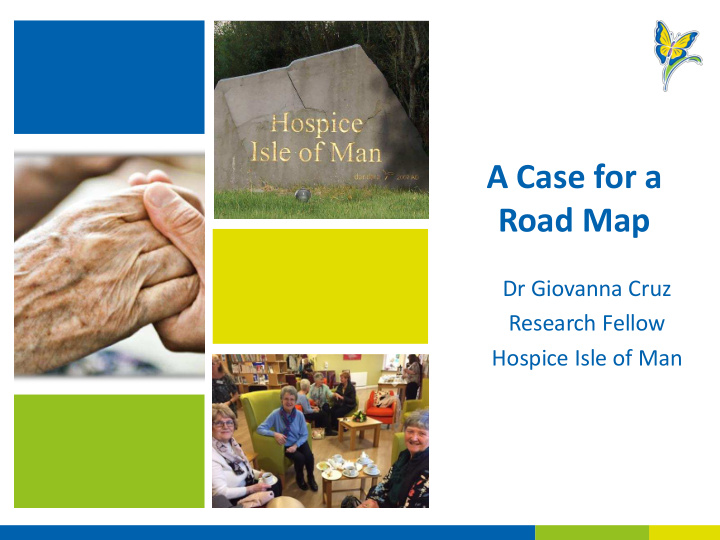



A Case for a Road Map Dr Giovanna Cruz Research Fellow Hospice Isle of Man
Background • To deliver person-centred and integrated end of life care, providers need to understand the experience of patients and carers from their own perspective. • Case study of a patient with a neurodegenerative condition and her carer. • Used as basis of workshop facilitated by IFIC Scotland to identify gaps in P & EoL care (Dec 2017).
Methods 1. Timeline – carer interview, e-mail with family, medical documents, personal diaries 2. Contacts of care – personal diaries (last 18 months) 3. Experience of care – interview with carer 3
Contacts of care Data extraction Analysis • Graphical representation of each provider (diary) • Number of contacts plotted by provider (diary) 4
Timeline Pre-diagnosis Diagnosis Complex Bereavement Care
Timeline Phase I – Pre-diagnosis • 2011 Early symptoms: Vision problems, arthritis, starting to lose muscle control, slower movements and frequent falls (not reported to GP). • Referral to rheumatologist. • Dec 2013 Increased problems with mobility, distress, anxiety, disability and dependence. • Continued deterioration as noticed by family – not explained by arthritis. • July 2014 Family suspects Parkinson’s Disease (PD). Start discussion with GP. • Referred to Neurologist who makes expected/probable diagnosis of PD.
Timeline Phase II – Diagnosis • Aug 2014 Parkinson’s nurse becomes involved; physiotherapy, OT services, to 2015 Independent Living Centre provide input. • Minimal improvement made with medication. • More falls and recurrent UTI’s • A&E visit after a fall – 4 stitches in eyebrow and 2 broken metacarpals. • Carer fully responsible for all household chores due to increased disability. • Aug 2015 Diagnosis changed to Progressive Supranuclear Palsy (PSP). • Wheelchair for occasional use.
Timeline Phase III – Increasing complexity of care • Nov 2015 Long-term Conditions Coordinator appointed and takes over care coordination for health services. • Family decides to move to Isle of Man to assist with care. • Dec 2015 Ambulance called and admitted to Hospital due to blood infection and UTI. • Fractured pelvis discovered upon examination. • GP refers to Hospice. • Jan 2016 Carer gradually overwhelmed. • to Feb Periodic one or two week in-patient respite (DHSC). • 2017 Third sector begins to provide respite support. • Private care agency contracted for help with showers. • Catheterisation. • Regular visits from District Nursing (DN) team. • Adaptations to home and medical equipment provided.
Timeline Phase IV – Last months • March Private nurse hired for night care and help at bed time. • 2017 Increased difficulty with symptom management – severity of spasms and pain increasing. • Multi-disciplinary team meeting held with family. • April 2017 Private domiciliary care during daytime and increased use of night nursing staff. • April 29 (Friday evening) – unable to control pain with medications available at home or with the help of telephone advice from emergency doctor service (MEDS). • Family takes patient to MEDS clinic for pain medication. • Sent home with oral morphine. • Family and private nurse care for patient until admitted to Hospice on May 1 (Monday) for previously scheduled respite.
Timeline Phase V – Death • May 1 to Patient cared for at Hospice Inpatient Unit until her death on June 3. • June 3 Carer very relieved and reassured once patient was admitted. 2017 Phase VI – Bereavement • June to Administrative tasks completed by carer. • December Long-term Conditions Coordinator arranges for removal of equipment 2017 and monitors carer. • Post-bereavement support offered to carer.
Patient’s wishes To stay at home as long as possible until it’s time to go to Hospice. 11
Ecosystem of care – last 18 months
Number of Encounters per Month by Sector January 1, 2016 to June 3, 2017 40 35 30 25 Encounters 20 15 10 5 0 Total DHSC 3rd Sector Private
Identified Gaps
Pre-diagnosis to diagnosis (2011-15) • Identifying complex cases • Triggers for signposting to community support • Self-management programme
Increasing complexity and disability • Care navigation – all sectors • IV antibiotics at home • Emotional wellbeing and respite • Anticipatory care planning • Carer support
Last year of life • Out of hours service availability • Review of preferred place of care 24 hour care
18
Thank You! Giovanna.Cruz@hospice.org.im
Recommend
More recommend